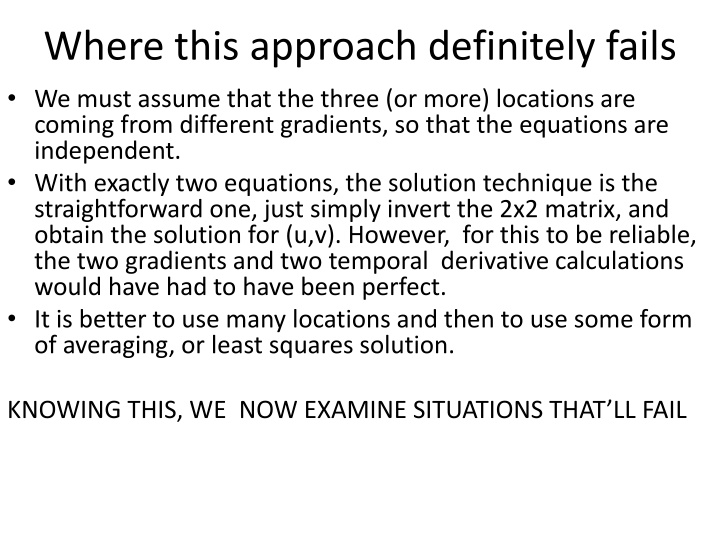Where this approach definitely fails
Motion detection approaches can fail when assumptions about linear intensity profiles, fast speeds, motion blur, dim lighting, uniform profiles, or wet surfaces are not met. Curved profiles, high speeds, and other factors can lead to inaccuracies in motion analysis.
Download Presentation

Please find below an Image/Link to download the presentation.
The content on the website is provided AS IS for your information and personal use only. It may not be sold, licensed, or shared on other websites without obtaining consent from the author.If you encounter any issues during the download, it is possible that the publisher has removed the file from their server.
You are allowed to download the files provided on this website for personal or commercial use, subject to the condition that they are used lawfully. All files are the property of their respective owners.
The content on the website is provided AS IS for your information and personal use only. It may not be sold, licensed, or shared on other websites without obtaining consent from the author.
E N D
Presentation Transcript
Where this approach definitely fails We must assume that the three (or more) locations are coming from different gradients, so that the equations are independent. With exactly two equations, the solution technique is the straightforward one, just simply invert the 2x2 matrix, and obtain the solution for (u,v). However, for this to be reliable, the two gradients and two temporal derivative calculations would have had to have been perfect. It is better to use many locations and then to use some form of averaging, or least squares solution. KNOWING THIS, WE NOW EXAMINE SITUATIONS THAT LL FAIL
Motion approach failures 1) Profile is Curved. Assumption was that the intensity profile is a linear ramp. But very often, the profile is more curved, like the left half of a Gaussian bell, or the rising part of a sine curve. This approach is based on Slope=Rise/Run. But, for a curved profile, the slope is not a stable value.
Motion approach failures 2) Speed too fast, second observation is beyond the ramp. Approach is based on Slope=Rise/Run. But, when second observation is beyond the ramp, it is coming from the flat part of the intensity, so the value used for Rise is incorrect.
Motion approach failures 3) Speed too fast, picture details all blurred due to speed. This is called motion blur.
Motion approach failures 4) Lights dim, and there is no motion, when the lights dim, the ramp is more shallow, so this will make it seems like there is a drop in the brightness value of the intensity profile. So, this may report a false motion.
Motion approach failures 5) A flat intensity profile, i.e. a uniform intensity/color, no edges at all. So, there is no image gradient, hence motion will not be seen, even if it exists.
Motion approach failures 6) Viewed surface could wetten, which might make it darker. This could make it seem like there is a drop in the brightness value of the intensity profile. So, this may report a false motion.
Motion approach failures 7) When combining points (2 or more) maybe still has only ONE edge direction. This would be from a case where all the edges in the viewing area are parallel. So the equations do not have enough independent equations needed for solving. 8) When combining (many) points, maybe some of the set are moving differently from the others; This will hurt the combination step. This situation arises in cases of: 8a) rotation: imagine looking at a spinning disk: every point moves with different velocity vector.
Motion approach failures 8b) fluid motion: imagine ocean waves and surf, or a waving flag; every point moves with different velocity vector. 8c) chaotic motion: room full of flying insects, or a snowstorm: chaotic motion.
Motion approach failures 8d) simple non-rigid (articulated) object moving: imagine looking at a large animal move; the motions of neighboring points on the animal will not be uniformly constant.
Motion approach failures 8e) moving camera in presence of depth jump/boundary: This is sometimes called motion parallax; even though the world may be rigid, when you are travelling on a road, the buildings nearby move faster (on your eye s screen) than an adjacent (only appears adjacent in the image) building that is very far away.























